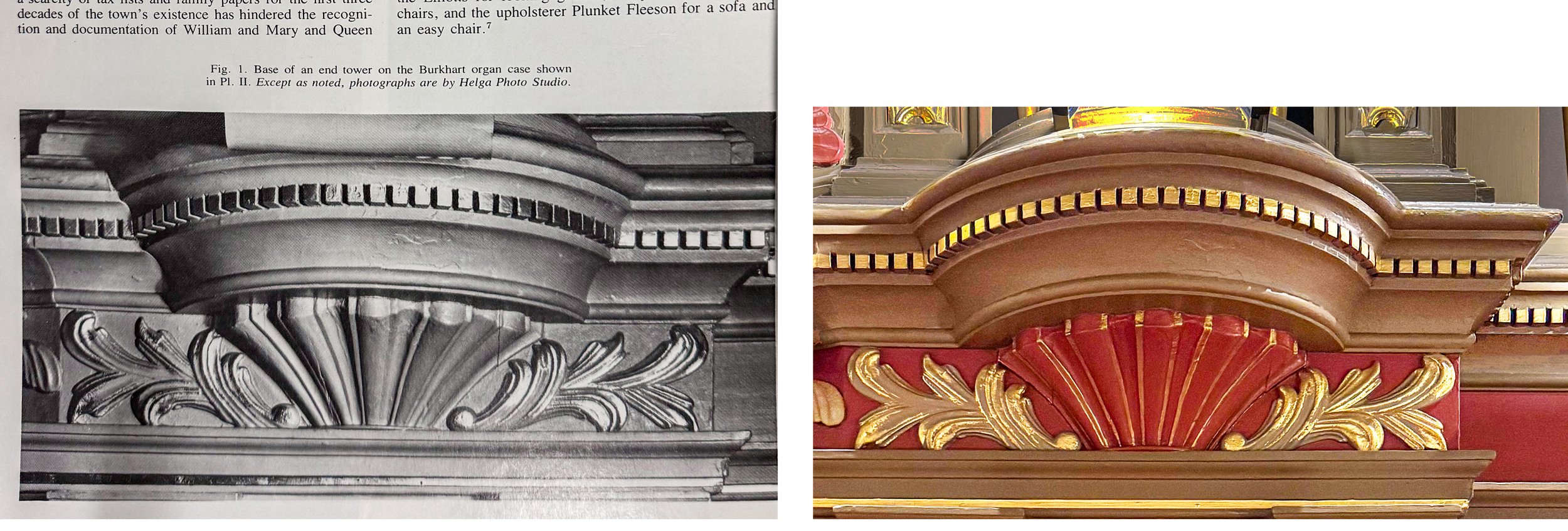The 1770 Organ Case at First Reformed UCC Church
A Showcase of Lancaster Chippendale Craftsmanship
By Cabinetmaker George Burkhart:
The 1770 organ case by George Burkhart. It’s an icon of Lancaster Chippendale design.
1975 Antiques Magazine
The Organ Case at First Reformed Church
It’s “the earliest piece of Lancaster Chippendale case furniture…”
John J. Snyder, Jr. (1946 - 2013) was Lancaster’s antiquarian extraordinaire. He was a leading historian of local architecture and arts.
In 1975 John Snyder published a definitive article in Antiques magazine about Lancaster Chippendale furniture. In that article he identified a Lancaster style of Chippendale woodworking.
He defined Lancaster’s Chippendale furniture as a style that was initiated by Germanic craftsmen who were influenced by Philadelphia fashion between 1760 and 1810.
John Snyder explained that the earliest Lancaster piece reflecting this local Chippendale design is this organ case at First Reformed Church. Cabinetmaker George Burkhart built this case to contain the works of an organ built by David Tannenberg.
A Centerfold of Lancaster Organ Cases
In a 1975 Antiques Magazine:
The 1770 organ case by George Burkhart at First Reformed Church is “the earliest piece of Lancaster Chippendale case furniture that exhibits these regional characteristics.” (John Snyder, Antiques magazine, 1975.) Lancaster’s Trinity Lutheran Church received its organ in 1774, a few years after the Reformed congregation received theirs. The Lutheran organ was the largest and most expensive organ in the American colonies.
Both churchs’ cases were made for Tannenberg organs. The cases later had extensions added to both sides. Today the two organ cases survive in excellent form in their original Lancaster churches.
Thomas Chippendale: “The Shakespeare of English Furniture Makers”
Cabinetmaker George Burkhart was
Influenced by Chippendale’s 1762 Pattern Book:
Above left: This 1762 Director pattern book by Chippendale was owned in the 1780s by Scottish cabinetmaker William Stephen in Dundee, Scotland. (Image credit: Christies.com)
Above right: A title page of a later edition (Image credit: Amazon.com)
Above left: Engraving of an organ in Thomas Chippendale’s 1762 Director pattern book. Right: George Burkhart’s organ case at First Reformed Church repeats design elements from that book, including ogee arches and carved pendant bellflowers.
Thomas Chippendale has been described by Christie’s as the Shakespeare of English furniture makers. The 1762 edition of his Director pattern book is often considered the most important 18th-century collection of English furniture designs.
That 1762 edition includes an engraving of an organ case that has similarities to George Burkhart’s 1770 case. Apparently Burkhart or an associate had access to the book. George Burkhart wanted the best possible designs for his Lancaster organ case.
Above: Detail of George Burkhart’s organ case in First Reformed Church as it appears in the 1975 Antiques magazine article (left) and as it appears today (right).
The Outstanding Georgian Townhouse
built by Cabinetmaker George Burkhart
for his family in 1762:
Above: The Burkhart House. Tower of today’s City Hall is visible in rear. Image source: LancasterHistory.org
Above: The 1762 Burkhart townhouse in the 1886 Sanborn map. Gray indicates stone construction, red is brick, yellow is wood / frame.
George Burkhart (1721 - 1783) was the most prosperous Lancaster cabinetmaker / joiner before the Revolution, as indicated by tax lists. He was a prominent member of this First Reformed Church.
When Burkhart was 29 years old, in 1750, he purchased a lot on the northwest corner of Duke St. and Orange St. He built his home and woodworking shop on that lot. A few years later he married Mary Doll (1731 – 1812). They had five children
In 1764 he built this large stone house on the corner of the lot for his growing family. It was one of the city’s finest stone houses at that time. He lived there the rest of his life.
Later, in the 1800s, this Burkhart townhouse became the home of prominent surgeon John Light Atlee and family. Dr. Atlee was a founder of the American Medical Association. The house was razed in 1900 to build St Paul’s Reformed Church. In 1981 that church was demolished to be replaced by today’s condo building, Steeple House Square.
1765: George Burkhart helped build the Church Parsonage:
The former Reformed Church parsonage:
49 North Duke Street, Lancaster
Carpenter / joiner George Burkhardt assisted with the construction of this Georgian-style parsonage in 1765.
The Reformed Church contructed this house to provide a home for the pastor and his family. This was a double structure. Adjoining in the building’s other half, to the right, was the church school which was built at the same time. The school is now demolished.
Georgian details of this building include a stone-and-brick water table, and a brick belt course. There are segmental arches and a modillioned cornice. The pedimented entry with pilasters is not original.
Return to this website’s index page about First Reformed UCC Church: Index page / Home.










